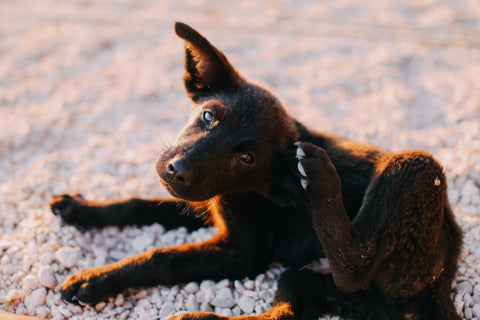With springtime in full swing, we’re enjoying the warmer weather and time outdoors. However, for some dogs and their owners, spring means a time of staying indoors and hiding away from all the pollen. Pollen is a common allergen for many people and their pets and can make springtime a challenging time. You can help your beloved pup get through this beautiful season and be outdoors to enjoy it all by watching for key symptoms and following a few easy tips!
What to watch for
- Itchy skin, especially around the paws, face, and armpits
- Areas with excessively pink coloration, especially around paws, ears, and eyes
- Obsessive paw licking
- Patchy hair loss
- Recurring ear infections

What to do
- Make sure there haven’t been any dietary changes recently - just like people, dogs can be allergic to certain foods or react poorly to a sudden change in their diet or environment. To help rule out food allergies, make sure to not change their food or add any new foods until the cause of the symptoms can be established by your veterinarian.
- Try dog allergy supplements - dog allergy supplements support your dog's immune system and ease overreactions to allergens by utilizing colostrum and bee pollen. Colostrum contains a specific protein that affects the function of the immune system by helping to regulate its reactions to irritants. Bee pollen contains crucian antihistamines and can help expose your dog to common spring allergens in a small, controlled quantity, which means that your dog's immune system will become desensitized to these allergens. Our Allerg-Ease supplements contain both of these crucial ingredients to help your pup get through their allergy season.
- Start tracking symptoms to see if there are any patterns in behavior - this can help you determine if there are any flare-ups or increases in symptoms after certain activities, such as going for an afternoon walk.
- Bathe your pet more frequently - increasing the frequency of baths will help to wash off irritants, such as pollen. However, don’t bathe your dog too frequently as this can negatively impact their skin health by removing protective oils from their fur and skin, check with your veterinarian or groomer to see how frequently you can bathe your dog based on their coat and skin type. In between baths, you can use pet-safe wet wipes to get off excess dirt and pollen from the surface of their coat. Check out the DERMagic line of pet-safe soaps, shampoos, and conditioners to try out for your pup!
- Use soothing creams on face and feet - this can help to ease the itching and prevent your pup from accidentally injuring themselves with excessive scratching or gnawing. Depending on the level of dryness your dog experiences during their allergy season, try out the DERMagic Lotion or DERMagic Cell Restoration Creme to help support your pup's skin.
- Change your activity schedule - try to go outside with your dog during times when pollinating plants are less active, such as early morning while the grass is still wet. If you know what type of plant your pet is allergic to specifically, you can avoid locations where there is an abundance of these plants, which can help reduce the number of flare-ups.
- See your veterinarians if symptoms do not decrease or resolve over time - it’s always a good idea to have your veterinarian check your pet for allergies, especially if symptoms don’t seem to ease over time.


